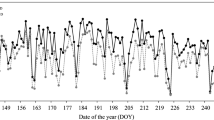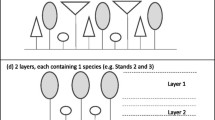Abstract
A model simulating the three-demensional crown architecture of a plant was developed with the objective of assessing the light capture and whole-plant carbon gain consequences of leaf display in understory plants. This model uses geometrical measurements taken in the field to reconstruct the projected image of a plant so that light absorption from any direction can be assessed. The photon flux density (PFD) from a given direction was estimated from the canopy openness derived from hemispherical canopy photographs and equations simulating the daily course of direct and diffuse PFD. For diffuse PFD, the directional fluxes and absorbed PFD were integrated over 160 different directions representing 8 azimuth classes and 20 elevation angle classes. Direct PFD absorption was determined for the time that a solar track on a given day intersected a canopy gap. Assimilation rate was simulated for the sunlit and shaded parts of leaves separately and then summed to give the whole-plant carbon gain. Comparisons of simulations for a tropical forest edge species, Clidemia octona, and an understory species, Conostegia cinnamomea, illustrate the operation of the model and show that the edge species is more efficient at capturing side light while the understory species is slightly more efficient at capturing light from directly above, the predominant light direction in this environment. Self-shading within Conostegia crown and steep leaf angles in the Clidemia crown reduced light capture efficiencies for light from directly above. Whole-plant daily carbon gain was much higher in the forest edge site, mostly because of the additional PFD available in this site. However, simulations for both species in the understory light environment show that the higher light capture efficiencies of the understory species in this environment conferred a 27% advantage in carbon gain in this environment.
Similar content being viewed by others
References
Ackerly DA, Bazzaz FA (1985) Seedling crown orientation and interception of diffuse radiation in tropical forest gaps. Ecology 76: 1134–1146
Becker P, Erhart DW, Smith AP (1989) Analysis of forest light environments. Computerized estimation of solar radiation from hemispherical canopy photographs. Agric For Meteorol 44: 217–232
Campbell GS (1977) An introduction to environmental biophysics. Springer, Berlin Heidelber New York, pp 175–177
Chazdon RL (1985) Leaf display, canopy structure and light interception of two understory palm species. Am J Bot 72: 1493–1502
Chazdon RL (1986) The costs of leaf support in understory palms: economy vs. safety. Am Nat 127: 9–30
Chazdon RL, Field CB (1987) Photographic estimation of photosynthetically active radiation: evaluation of a computerized technique. Oecologia 73: 525–527
Dickmann DI, Michael DA, Isebrands JG, Westin S (1990) Effects of leaf display on light interception and apparent photosynthesis in two contrasting Populus cultivars during their second growing season. Tree Physiol 7: 7–20
Farnsworth KD, Niklas KJ (1995) Theories of optimization form and function in branching architecture in plants. Funct Ecol 9: 335–363
Fisher JB (1986) Branching patterns and angles in trees. In: Givnish TJ (ed) On the economy of plant form and function. Cambridge University Press, Cambridge, pp 493–524
Fisher JB, Honda H (1977a) Branch geometry and effective leaf area: a study of Terminalia branching pattern. I. Theoretical trees. Am J Bot 66: 633–644
Fisher JB, Honda H (1977b) Branch geometry and effective leaf area: a study of Terminalia branching pattern. II. Survey of real trees. Am J Bot 66: 645–655
Givnish TJ (1986) Biomechanical constraints on crown geometry in forest herbs. In: Givnish TJ (ed) On the economy of plant form and function. Cambridge University Press, New York, pp 525–584
Gutschick VP, Wiegel FW (1988) Optimizing the canopy photosynthetic rate by patterns of investment in specific leaf mass. Am Nat 132: 67–86
Halle F, Oldemann RAA, Tomlinson PB (1978) Tropical trees and forests: an architectural analysis. Springer, Berlin Heidelberg New York
Honda H, Fisher JB (1978) Tree branch angle: maximizing effective leaf area. Science 199: 888–890
Honda H, Tomlinson PB, Fisher JB (1981) Computer simulation of branch interaction and regulation by unequal flow rates in botanical trees. Am J Bot 68: 569–585
Hutchison BA, Matt DR, McMillen RT (1980) Effects of sky brightness distribution upon penetration of diffuse radiation through canopy gaps in a deciduous forest. Agric For Meteorol 22: 137–147
Kuppers M (1985) Carbon relations and competition between woody species in a Central European hedgerow. IV. Growth form and partitioning. Oecologia 66:343–352
Lambers H, Poorter H (1992) Inherent variation in growth rate between higher plants: a search for physiological causes and ecological consequences. Adv Ecol Res 23: 188–261
Miller PC, Stoner WA (1979) Canopy structure and environmental interactions. In: Solbrig OT, Jain S, Johnson GB, Raven PH (eds) Topics in plant population biology. Columbia University Press, New York, pp 428–458
Monsi M, Uchijima Z, Oikawa T (1973) Structure of foliage canopies and photosynthesis. Annu Rev Ecol Syst 4: 301–328
Myneni RB (1991) Modeling radiative transfer and photosynthesis in three-dimensional vegetation canopies. Agric For Meteorol 55: 323–344
Myneni RB, Impens I (1985) A procedural approach for studying the radiation regime of finite and truncated foliage spaces. II. Experimental results and discussion. Agric For Meteorol 34: 3–16
Niklas KJ (1988) The role of phyllotactic pattern as a “developmental constraint” on the interception of light by leaf surfaces. Evolution 42: 1–16
Oker-Blom P (1984) Penumbral effects of within-plant and between-plant shading on radiation distribution and leaf photosynthesis: a monte-carlo simulation. Photosynthetica 18: 522–528
Pearcy RW, Chazdon RL, Gross LJ, Mott KA (1994) Photosynthetic utilization of sunflecks: A temporally patchy resource on a time scale of to minutes. In: Caldwell MM, Pearcy RW (eds) Exploitation of environmental heterogeneity by plants. Academic Press, San Diego, pp 175–208
Rich PM (1990) Characterizing plant canopies with hemispherical photographs. Remote Sensing Rev 5: 13–29
Ryel RJ, Beyschlag W, Caldwell MM (1993) Foliage orientation and carbon gain in two tussock grasses as assessed with a new whole-plant gas-exchange model. Funct Ecol 7: 115–124
Takenaka A (1994) Effects of leaf blade narrowness and petiole length on the light capture efficiency of a shoot. Ecol Res 9: 109–114
Thornley JHM (1976) Mathematical models in plant physiology. Academic Press, London
Waller DM, Steingraeber D (1986) Branching and modular growth: theoretical models and empirical patterns. In: Jackson JBC, Buss LW, Cook RE (eds) The population biology and evolution of clonal organisms. Yale University Press, New Haven
Wang YP, Jarvis PG (1990) Influence of crown structural properties on PAR absorption, photosynthesis and transpiration in sitka spruce: application of a model (Maestro). Tree Physiol 10: 297–316
Whitehead D, Grace JC, Godfrey MJS (1990) Architectural distribution of foliage in individual Pinus radiata D. Don crowns and the effects of clumping on radiation interception. Tree Physiol 7: 135–155
Author information
Authors and Affiliations
Corresponding author
Rights and permissions
About this article
Cite this article
Pearcy, R.W., Yang, W. A three-dimensional crown architecture model for assessment of light capture and carbon gain by understory plants. Oecologia 108, 1–12 (1996). https://doi.org/10.1007/BF00333208
Received:
Accepted:
Issue Date:
DOI: https://doi.org/10.1007/BF00333208




